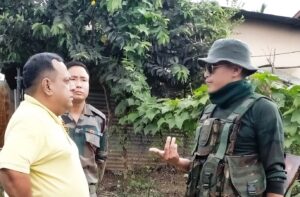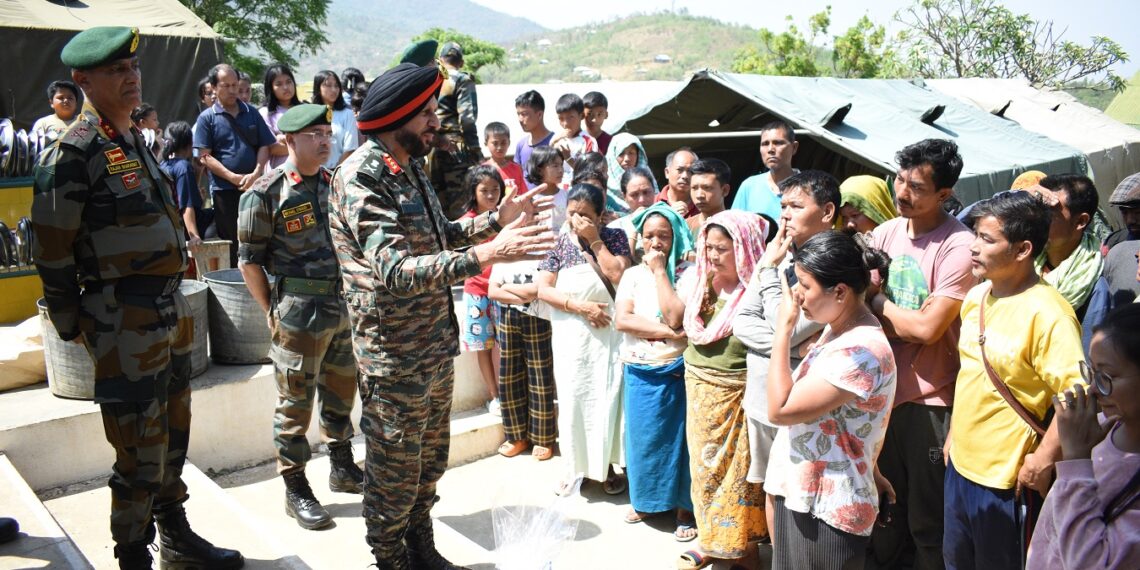Jonathan Roy Tariang: Sir, we have been given to understand that you are presently travelling in trouble torn Manipur. What exactly has taken you there?
Jaideep Saikia: I am trying to revisit some of the areas in the North East that I have been studying over the years. To that end, I recently returned from Nagaland—my observations of what I witnessed in the state were published in Northeast News in an interview that I had given to Dr. Alex Waterman of the United Kingdom. However, the atmospherics in Manipur necessitated an on-the-spot comprehension of some of the issues that led to the outbreak of violence in the state. It is with that in mind that I have come to Manipur.
JRT: Which are the places in Manipur that you have already visited?
JS: I arrived in Imphal on 3 October 2023 and spent almost the entire day receiving briefings by the Indian army, the Assam Rifles and meeting representatives of the Manipur Press, traders and other stakeholders.
I helicoptered down to Churachandpur on 4 October 2023 and am presently here. I plan to return to Imphal on 6 October 2023 and meet some more people including members of the Civil Society Organisations.
JRT: What have been your initial observations?
JS: Well, apart from the “remains of the past”—I am referring to the plethora of signs that accompanied the violence that have been occurring in the state and the wall graffiti that spelt the manner in which various demands are being made by the warring parties (Meities and Kukis)—it was difficult for me to discern that anything was amiss. I mean life and business seemed normal in both Imphal and Churachandpur. The normalcy was heartening because the reportages that visit one in places such as Guwahati were always painting a picture that showcased burning houses, protest marches and signs of unrest.
I did see a number of sit-ins in Imphal, primarily by women-folk demanding stern action against the reported abduction and “murder” of the two students, 20-year-old boy, Phijam Hemanjit Singh and 17-year-old girl, Linthoinganbi. As your readers may be aware, photographs of the two students surfaced on social media on 25 September last. The abduction, incidentally, had reportedly taken place in July, but the release of the photographs—which went viral—led to violent protests with even agitators attempting to vandalise the ancestral house of the Chief Minister of Manipur.
I also saw the properties of both communities—in the two places, i.e., Imphal and Churachandpur—being destroyed. It would be of interest to your readers to note that the names of places that were vandalised have been changed. For instance, a locality in Imphal that had housed people from the Kuki or affiliated communities and which was known as Paite Veng has now been renamed as Ningthemkhol. Of course, the Kukis no longer refer to Churachandpur by that name. They call it Lamka which means “cross-roads” or “junction”.

JRT: Why are you terming it as renaming?
JS: Because, in Imphal the area which was known as Paite Veng had been earlier sold by the Meitei community to the Kukis. The locality before the sale was Ningthemkhol. Similarly, there is a complete move by the Kukis to disassociate themselves from the Manipur as one knew it.
But the aspect that one has to take in is that there is now an almost state of no-return and I, for the life of me, cannot fathom a return to the days prior to 3 May 2023. The divide is complete.
I was invited by the Manipur University and the Assam Rifles in 2022 to deliver a lecture on the “Act East Policy”. The student in me knew about the Hill-Valley Divide and the animosities. Indeed, I had made a trip to Churachandpur at the time as well. The journey from Imphal was by road. But the 200 Km odd trip this time around had to be undertaken by helicopter as there are blockades galore in the National Highway 2.
JRT: How different was the narrative in Meitei dominated Imphal and Kuki dominated Churachandpur?
JS: Oh! It is as different as night and day. Each community continues to hold on to their ground. There is no commonality. It is strange because I should have thought that the “fatigue factor” should have set in by now. But, a quick assessment of the ground reality informs that it would be quite a while before “durable peace” is achieved. The fact that news such as the abduction of the two students keep coming to the fore—even after passage of time—acts as booster-shots for the bitterness.
I have already told you about the protests that erupted in Imphal after the photographs of the two students were released on social media. I am yet to come to terms with some of the aspects that the student of national security in me is beginning to learn about conflict (not necessarily of the Manipur manner!), but the arrests of four persons from Henglep area of Churachandpur for the reported “murder” of the two students are being decried by the Kuki community. Yesterday (4 October 2023), I met Ginza Vualzong, the spokesperson of the Indigenous Tribal Leaders Forum. He told me that the apprehensions are unfair and were done in surreptitious circumstances by central agencies. He also told me that the narrative has been led by a right-wing Hindutva agenda that are trying to both discredit and disturb the Christianity way of life in the region. I really don’t know what to make of the allegations or pass a value judgment on such a viewpoint, but New Delhi has to take a call and inform the nation as to how it wishes to mould India of the future. After all, the anger is very palpable. As I said in an earlier interview, course correction steps have to be taken in right earnest. The “enchanted frontiers” would surely be imperiled if such adhocism continues.
JRT: How was your interaction with the trading community of Imphal like?
JS: Most of the important traders of Manipur are from Rajasthan and Punjab. They have told me that their businesses have suffered considerably (a) as a result of the mass exodus of the Kuki community from Imphal and (b) because since August this year they are being subjected to huge extortions by groups of all hues and shapes.
JRT: Why have they suffered as a result of the Kuki exodus?
JS: Well, it is interesting, but I was told by representatives of the trading community that the Kukis had the greatest purchasing power. Naturally with their exit, business has suffered.
JRT: The Assam Rifles was termed partisan because they were seen to be taking sides. What have been your impression?
JS: I have said this earlier and I am going to reiterate it again. The Indian army and the Assam Rifles have been the only two lone and sane voices in the babble of madness that has engulfed Manipur.
Indeed, had it not been for the Indian army and the Assam Rifles that have walked the extra mile to keep aspects under control, the situation in the state would have been one of wanton violence bordering on bloodbath.
I am very disturbed by the fact that the state of affairs in a sensitive border Indian state has come to such a pass. As you are aware, Manipur sits cheek-by-jowl with restive Myanmar. It is also a state which continues to be resistant to almost all forms of counter insurgency operations. The Sagaing Division of Myanmar houses the “three neat clusters” for the Valley-Based-Insurgent-Groups that are now entering the state to chaperon the unrest.
Manipur was meant to be the launching pad for the ambitious “Act East Policy”. But the conflict has put paid to all such dreams. It is a matter of time that anti-India powers would use Manipur to fish in troubled waters. Such a state of affairs, does not augur at well for India’s security. I am also distressed that New Delhi has not been able to come out with anything concrete to salvage the situation. If anything, it speaks volumes about the incompetence of India’s national security managers.
JRT: Are the Valley-Based-Insurgent-Groups still bound by a Coordination Committee?
JS: Well, I think one would see a new-look Coordination Committee soon. As you are aware, the United National Liberation Front (Pambei) has shown interest in entering into a dialogue process with New Delhi. The move has not gone down well with the other members of the Coordination Committee, namely the Kangleipak Communist Party, Kanglei Yawol Kanna Lup, People’s Revolutionary Party of Kangleipak, People’s Revolutionary Party of Kangleipak (Progressive), Revolutionary People’s Front which is the political wing of the People’s Liberation Army. They have ostracised the United National Liberation Front (Pambei) group and have come together as the G-5 (Group of Five). I think a re-organisation effort would be witnessed in about a year’s time.
JRT: Three separate administrative zones for the Nagas, Meiteis and the Kukis (and affiliated groups) have been demanded for. What are your views on the matter?
JS: I have always maintained that geography is awry in Manipur and cartographical dissonance is the primary reason for the Hill-Valley Divide. The special provisions that were provided to the tribals in stark opposition to the Valley dwellers who were not given any land rights in the Hills aggravated that divide.
I am not certain as to whether carving out three separate administrative set-ups would work in the long run. In fact, it might worsen matters.
JRT: Why are you saying that it would worsen matters?
JS: Because sooner of later the Nagas—who have no love lost for the Kukis—will come into conflict with the Kukis over division of the Hills of Manipur. I do not want to come across as a prophet of doom, but the conflict that would ensue if and when separate administrative zones are shaped would be worse than the one which has been witnessed in the last five months.















